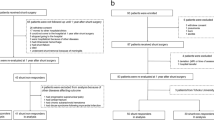Abstract
Objective: The diagnosis and management of idiopathic normal-pressure hydrocephalus (iNPH) remains controversial, particularly in selecting patients for shunt insertion. Diagnostic criteria target the pathological features of the dynamics of the cerebrospinal fluid (CSF); however, the effectiveness in predicting the shunt success has room for improvement. The aim of our study was to systematically assess the influence of the co-morbidity determining the benefit from shunt surgery.
Methods: Between 1997 and 2006 134 patients suffering from iNPH were treated with a ventriculo-peritoneal shunt with a gravity-controlled valve. The coincident disease processes were recorded. Shunt outcome was assessed at 2 years postsurgery in 116 patients (follow up rate 87%). The results of this follow-up examination (Kiefer score, NPH recovery rate) were compared using the preoperative co-morbidity index (CMI).
Results: Of the 134 patients 76 (56.7%) had a CMI of 0–3 and 58 patients (43.3%) had a CMI of 4–8. Two years after surgery 65 out of 70 shunt responders (93%) could be identified in the patients group with a CMI of 0–3 and only 29 of 46 (63%) in group with a CMI of 4–8. This difference was significant (p < 0.0001). Remarkably few patients scoring between 6 and 8 on the CMI scale experienced a favourable outcome. The patients in this latter group showed excellent outcomes in only 1% and poor outcomes in 33%.
Conclusion: Data in this report affirm that co-morbidity is a statistically significant predictor of the quality of the clinical outcome for patients with iNPH undergoing shunt therapy. A CMI of more than 3 significantly decreases the chance of a favourable outcome and this should form part of the assessment when the risks and benefits of surgery are considered. According to these data, a successful outcome in patients with a CMI of 6 or more is not to be expected.
Access this chapter
Tax calculation will be finalised at checkout
Purchases are for personal use only
Similar content being viewed by others
References
Al-Zain F, Meier U, Lemcke J (2010) Early shunting using the parallel shunt system in hemorrhagic hydrocephalus: in vitro testing of handling, technical complications and clogging rate. Acta Neurochir Suppl 106:117–119
Bech RA, Waldemar G, Gjerris F, Klinken L, Juhler M (1999) Shunting effects in patients with idiopathic normal pressure hydrocephalus; correlation with cerebral and leptomeningeal biopsy findings. Acta Neurochir (Wien) 141:633–639
Borgesen SE (1984) Conductance to outflow of CSF in normal pressure hydrocephalus. Acta Neurochir (Wien) 71:1–45
Golomb J, de Leon MJ, George AE, Kluger A, Convit A, Rusinek H, de Santi S, Litt A, Foo SH, Ferris SH (1994) Hippocampal atrophy correlates with severe cognitive impairment in elderly patients with suspected normal pressure hydrocephalus. J Neurol Neurosurg Psychiatry 57:590–593
Golomb J, Wisoff J, Miller DC, Boksay I, Kluger A, Weiner H, Salton J, Graves W (2000) Alzheimer’s disease comorbidity in normal pressure hydrocephalus: prevalence and shunt response. J Neurol Neurosurg Psychiatry 68:778–781
Hertel F, Zuchner M, Decker C, Schill S, Bosniak I, Bettag M (2008) The Miethke dual switch valve: experience in 169 adult patients with different kinds of hydrocephalus: an open field study. Minim Invasive Neurosurg 51:147–153
Kahlon B, Sjunnesson J, Rehncrona S (2007) Long-term outcome in patients with suspected normal pressure hydrocephalus. Neurosurgery 60:327–332
Kiefer M, Eymann R, Steudel WI (2006) Outcome predictors for normal-pressure hydrocephalus. Acta Neurochir Suppl 96:364–367
Lemcke J, Meier U (2010) Improved outcome in shunted iNPH with a combination of a Codman Hakim programmable valve and an Aesculap-Miethke ShuntAssistant. Cen Eur Neurosurg 71:113–116
Meier U (2002) The grading of normal pressure hydrocephalus. Biomed Tech(Berl) 47:54–58
Meier U, Lemcke J (2006) First clinical experiences in patients with idiopathic normal-pressure hydrocephalus with the adjustable gravity valve manufactured by Aesculap (proGAV(Aesculap)). Acta Neurochir Suppl 96:368–372
Meier U, Lemcke J (2007) Diagnostic methods of normal pressure hydrocephalus. Schweiz Arch Neurol Psychiatr 158:139–149
Meier U, Lemcke J, Neumann U (2006) Predictors of outcome in patients with normal-pressure hydrocephalus. Acta Neurochir Suppl 96:352–357
Pujari S, Kharkar S, Metellus P, Shuck J, Williams MA, Rigamonti D (2008) Normal pressure hydrocephalus: long-term outcome after shunt surgery. J Neurol Neurosurg Psychiatry 79:1282–1286
Savolainen S, Paljarvi L, Vapalahti M (1999) Prevalence of Alzheimer’s disease in patients investigated for presumed normal pressure hydrocephalus: a clinical and neuropathological study. Acta Neurochir (Wien) 141:849–853
Savolainen S, Laakso MP, Paljarvi L, Alafuzoff I, Hurskainen H, Partanen K, Soininen H, Vapalahti M (2000) MR imaging of the hippocampus in normal pressure hydrocephalus: correlations with cortical Alzheimer’s disease confirmed by pathologic analysis. AJNR Am J Neuroradiol 21:409–414
Sprung C, Schlosser HG, Lemcke J, Meier U, Messing-Junger M, Trost HA, Weber F, Schul C, Rohde V, Ludwig HC, Hopfner J, Sepehrnia A, Mirzayan MJ, Krauss JK (2010) The adjustable proGAV shunt: a prospective safety and reliability multicenter study. Neurosurgery 66:465–474
Conflict of interest statement
We declare that we have no conflict of interest.
Author information
Authors and Affiliations
Corresponding author
Editor information
Editors and Affiliations
Rights and permissions
Copyright information
© 2012 Springer-Verlag/Wien
About this chapter
Cite this chapter
Lemcke, J., Meier, U. (2012). Idiopathic Normal Pressure Hydrocephalus (iNPH) and Co-Morbidity: An Outcome Analysis of 134 Patients. In: Schuhmann, M., Czosnyka, M. (eds) Intracranial Pressure and Brain Monitoring XIV. Acta Neurochirurgica Supplementum, vol 114. Springer, Vienna. https://doi.org/10.1007/978-3-7091-0956-4_50
Download citation
DOI: https://doi.org/10.1007/978-3-7091-0956-4_50
Published:
Publisher Name: Springer, Vienna
Print ISBN: 978-3-7091-0955-7
Online ISBN: 978-3-7091-0956-4
eBook Packages: MedicineMedicine (R0)




